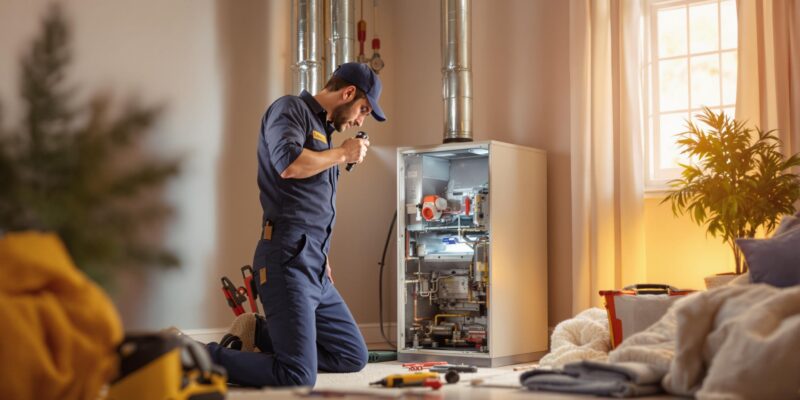10 Tips To Extend HVAC System Lifespan
Your HVAC system is a big investment, and taking care of it can save you money, improve home comfort, and avoid costly repairs. Here’s how to make it last longer:
- Schedule Regular Maintenance: Book professional checkups twice a year – spring for cooling, fall for heating.
- Replace Air Filters: Change filters regularly to maintain airflow and prevent system strain.
- Clean Air Ducts: Keep ducts free from dust and debris to improve efficiency.
- Use a Smart Thermostat: Automate temperature control to reduce wear and lower energy use.
- Clear Outdoor Units: Remove debris and keep at least 2 feet of space around the unit.
- Seal Duct Leaks: Prevent air loss by sealing and insulating ductwork.
- Check Home Insulation: Improve insulation in attics, walls, and basements to ease system workload.
- Set Fan to “Auto”: Avoid running the fan continuously to reduce motor wear.
- Fix Issues Quickly: Address small problems early to prevent costly breakdowns.
- Work with Professionals: Partner with certified technicians for expert care and repairs.
These simple steps can extend your HVAC system’s lifespan, improve efficiency, and save you money over time.
How Do I Prolong the Life of My HVAC System? | Western …
1. Book Regular Maintenance Checks
Scheduling regular HVAC maintenance helps keep your system running smoothly and avoids expensive repairs. Aim to schedule these checks twice a year – once in early spring for cooling and again in early fall for heating. This timing ensures that any potential problems are addressed before peak usage.
During these visits, certified technicians handle key tasks, such as:
- Testing system performance to ensure efficiency
- Inspecting electrical connections for wear and tear
- Calibrating the thermostat for accurate operation
- Cleaning components to remove dust buildup
Keeping up with maintenance not only extends the life of your HVAC system but also ensures it operates efficiently. Hydrodynamics Inc. offers comprehensive maintenance programs, including detailed inspections of every component. Schedule your spring and fall maintenance today to stay ahead of potential issues.
2. Change Air Filters on Schedule
Replacing your air filters regularly is key to keeping your HVAC system running smoothly and lasting longer. Clean filters prevent dust and debris from clogging important components, reduce strain on the system, and maintain proper airflow. The first step is figuring out how often to change them based on your household’s needs.
The replacement schedule depends on factors like indoor air quality. For example:
- A single-person household might need a change every few months.
- Homes with pets or high activity levels may require monthly replacements.
- Vacation homes typically need less frequent changes.
Choose filters with the right MERV rating for your system. Filters rated between 8 and 13 work well for most residential setups, offering good filtration without restricting airflow too much. However, using filters with higher ratings can strain your system if it’s not designed for them.
To stay on track, mark your calendar for filter changes, check them periodically, and keep extras on hand. Always follow the directional arrows when installing new filters.
A clogged filter makes your HVAC system work harder, which can lead to higher energy bills and potential damage. If you’re not sure which filter or schedule is best for your setup, Hydrodynamics Inc. can help with tailored advice based on your system and usage.
3. Keep Air Ducts Clean
Dust and debris in your air ducts can block airflow, making your system work harder and lowering its efficiency. Look out for signs like dust buildup around vents, inconsistent temperatures between rooms, or musty smells – these often indicate it’s time for a professional cleaning.
Here are some signs your ducts might need attention:
- Dust collecting around air vents
- Uneven heating or cooling across rooms
- Musty smells coming from the vents
DIY cleaning usually isn’t enough to tackle the hidden buildup inside ducts. Professional services, like those offered by Hydrodynamics Inc., use specialized tools to thoroughly clean your air ducts without causing damage.
If you notice any of these issues, don’t wait – schedule a professional duct cleaning to keep your system running smoothly.
4. Use a Smart Thermostat
A smart thermostat helps lower energy bills and reduces wear on your HVAC system by maintaining steady temperature control and limiting unnecessary use.
Here’s what makes it effective:
- Automated scheduling: Keeps your system running smoothly without constant manual adjustments.
- Learning capabilities: Adjusts to your daily habits, cutting down on frequent on/off cycling.
- Remote control: Lets you avoid extreme, sudden temperature changes from anywhere.
By preventing short cycling – when your system turns on and off too often – a smart thermostat supports longer, more efficient operating cycles.
For the best results, adjust temperatures gradually following the manufacturer’s instructions. It’s also a good idea to have a professional handle the installation and calibration to ensure everything is set up correctly.
Adding a smart thermostat is a simple way to enhance your system’s performance while pairing well with regular maintenance.
5. Keep Outdoor Units Clear
Make sure your outdoor HVAC unit has proper airflow. When debris builds up, it forces the system to work harder, which can lead to more wear and tear and a shorter lifespan.
Maintain at least 2 feet of space around all sides of the unit. Regularly take these steps to keep the area clear:
- Remove grass clippings, leaves, and twigs from around the unit
- Trim back shrubs and plants nearby
- Clear snow and ice during winter
- Keep storage items away from the unit
Check the top of the unit for debris, especially after storms. Leaves and other materials can fall through the grille and block internal parts. You can gently clean the exterior, but avoid using pressure washers – they can damage the delicate fins.
Using a protective cover in the fall can help keep leaves out, but be sure to remove it before using the system.
Inspect the base of the unit to ensure it’s level and stable. An uneven foundation can cause vibrations that wear down components faster. If the concrete pad is settling or cracking, have a professional check it out.
For best results, schedule professional cleaning of the condenser coils at least once a year. This removes dirt and grime that regular maintenance can’t handle, improving heat transfer and system efficiency. Stick to these steps, and your unit will run smoothly until its next professional inspection.
Leave internal cleaning and repairs to the experts.
6. Fix Duct Leaks and Add Insulation
Sealing and insulating your ducts is key to keeping your HVAC system running efficiently and lasting longer. When air leaks out or insulation is lacking, your system has to work harder, which can wear it out faster.
Check your ductwork by looking at accessible areas like attics, basements, and crawl spaces. Look for gaps or disconnects where air might escape. If you spot leaks, use duct-specific sealing products to close them up. Adding insulation to the ducts helps keep air at the right temperature, reducing energy waste and improving system performance.
Taking these steps can help your HVAC system run more efficiently and last longer.
7. Check Home Insulation
Your home’s insulation plays a big role in how efficiently your HVAC system runs and how long it lasts. If your insulation isn’t up to par, your system has to work overtime, leading to quicker wear and tear.
Here are the key areas to focus on:
- Attic: Proper insulation helps reduce heat loss.
- Exterior Walls: Good insulation keeps indoor temperatures steady.
- Basement/Crawl Space: Insulation here helps maintain consistent temperatures throughout your home.
Signs of poor insulation include uneven room temperatures, drafts, or rising energy bills. By improving your home’s insulation, you can ease the burden on your HVAC system and make sure all your maintenance efforts pay off.
8. Set Fan to “Auto” Mode
The fan setting on your HVAC system might seem like a small detail, but it has a big impact on energy use and system durability. Most systems give you two options: “On” and “Auto.” Choosing “Auto” means the fan runs only when heating or cooling is needed, while “On” keeps it running non-stop. Using the right setting can reduce wear and help your system last longer.
Here’s a quick breakdown of the differences:
| Feature | “Auto” Mode | “On” Mode |
|---|---|---|
| Operating Time | Runs only during heating/cooling cycles | Runs continuously |
| Energy Usage | Lower energy use | Higher energy use |
| Motor Wear | Less strain on the motor | More wear on the motor |
| Filter Life | Lasts longer, slower dust buildup | Shortens due to constant airflow |
Switching your fan to “Auto” can help you save energy, reduce strain on your system, and extend filter life. If you’re unsure about your settings, ask a professional to check them during your next service visit.
9. Fix Small Problems Quickly
Small HVAC issues can snowball into expensive repairs if ignored. Catching problems early and addressing them right away can save you from bigger headaches. Here are some common warning signs to watch for:
| Warning Sign | Possible Issue | What Could Happen |
|---|---|---|
| Unusual noises | Loose parts or failing components | Total component failure |
| Weak airflow | Blocked ducts or blower issues | System strain and eventual breakdown |
| Short cycling | Thermostat or sizing problems | Higher energy bills and wear |
| Strange odors | Mold or burnt wiring | Health risks or potential fire |
| Inconsistent temperatures | Failing parts or duct problems | Reduced comfort and efficiency |
Ignoring these signs makes your HVAC system work harder than it should, which speeds up wear and increases repair costs. Acting quickly when you notice changes in performance can prevent small problems from spiraling into major issues.
Calling a professional at the first sign of trouble not only helps avoid costly repairs but also keeps your system running efficiently for longer. Regular maintenance is key to ensuring your HVAC system stays in top shape.
10. Work with Hydrodynamics Inc.
Extend the life of your HVAC system by teaming up with seasoned professionals. Hydrodynamics Inc. specializes in HVAC maintenance and repair services designed to keep your equipment running smoothly and efficiently. Their proactive care approach aligns perfectly with the maintenance tips mentioned earlier.
Their certified technicians provide:
| Service Type | Benefits for Your System |
|---|---|
| Preventative Maintenance | Identifies issues early, avoiding costly breakdowns |
| System Repairs | Uses high-quality parts for durable fixes |
| Performance Optimization | Fine-tunes systems to improve efficiency and reduce strain |
| Ductwork Service | Cleans and seals ducts to enhance airflow and minimize wear |
| Energy Efficiency Updates | Implements updates to lower stress and operating costs |
Hydrodynamics Inc. employs EPA 609 Certified Technicians, ensuring they meet the highest industry standards. Their services include detailed inspections, expert cleaning, and precise adjustments to keep your HVAC system in top condition.
“Prompt, knowledgeable, and efficient”, says Emma K. from Drums, PA, praising the exceptional service that helps HVAC systems perform at their best.
They also handle a wide range of systems, including:
- Central air conditioning systems
- Heat pumps
- Ductless mini-split systems
- Industrial heating equipment
- Rooftop HVAC units
Conclusion
The tips shared here can help keep your HVAC system running smoothly and dependably. Regular upkeep and thoughtful usage not only improve performance but also help avoid expensive replacements.
Simple actions like changing filters and clearing debris around outdoor units can stop small problems from turning into major headaches. Regular checkups, using smart thermostat settings, and addressing minor issues quickly are key to maintaining your system’s efficiency over the years.
Taking these steps ensures your HVAC system stays in great shape and protects your investment.




